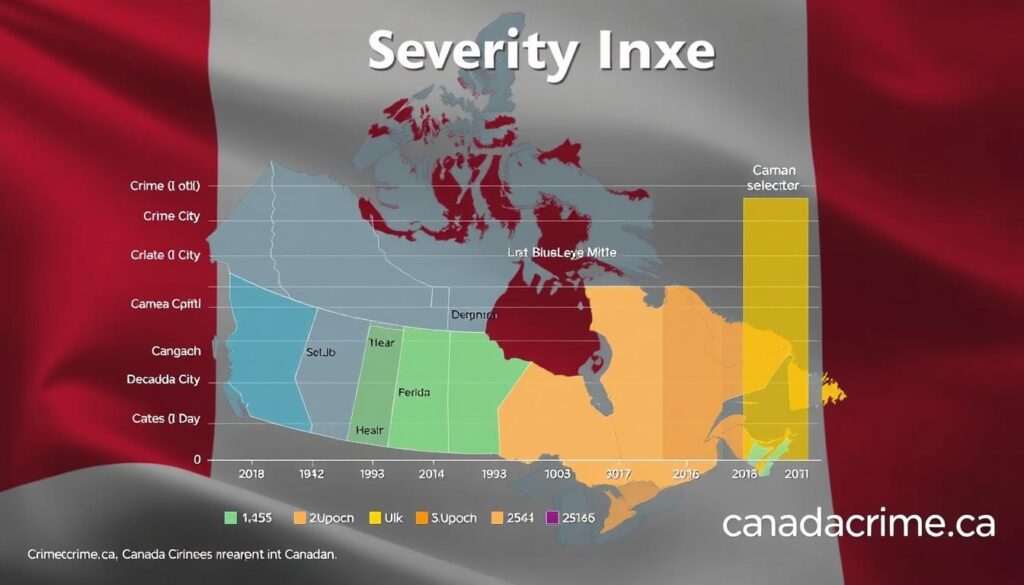Canada is often perceived as a safe haven, but certain urban areas face significant challenges related to crime trends. Recent data reveals that some Canadian cities experience higher crime rates due to various socioeconomic factors and law enforcement effectiveness. In this analysis, we explore the crime statistics that shape the safety landscape across Canada, shedding light on the complexities of urban safety.
The Crime Severity Index (CSI) is a crucial metric used to evaluate both violent and non-violent criminal activities in Canada. By examining the CSI and other relevant data, we can identify the Canadian cities with the most significant crime challenges and understand the regional variations in crime rates.
Understanding Crime Measurement in Canada
To comprehend the crime situation in Canada, it’s essential to understand how crime is measured. The country employs a sophisticated system to assess crime, going beyond mere numbers to provide a comprehensive picture.
Crime Severity Index (CSI) Explained
The Crime Severity Index (CSI) is a critical tool in evaluating the state of crime in Canada. It takes into account both the volume and severity of crimes reported to the police. In 2023, the CSI rose by 2%, marking the third consecutive year of increase, a trend that began in 2015. This rise was largely attributed to significant shifts in certain types of crime, particularly in the Non-violent CSI, while the Violent CSI saw minimal change.
The CSI is calculated by assigning different weights to crimes based on their severity. More serious crimes, such as homicide, carry greater weight than less serious offenses. This method provides a more nuanced understanding of crime trends than raw crime numbers alone.

Difference Between Violent and Non-Violent Crime Rates
Understanding the distinction between violent and non-violent crime rates is crucial. Violent crimes include offenses against persons, such as homicide, assault, and sexual assault. Non-violent crimes, on the other hand, primarily involve property offenses like theft, fraud, and breaking and entering.
In 2023, the police-reported crime rate per 100,000 people was 5,843, reflecting a 2.5% annual change. The Violent Crime Severity Index and the Non-violent Crime Severity Index recorded values of 99.5 and 73.5, respectively. These statistics highlight the importance of considering both types of crime when assessing overall crime trends.
| Crime Index | 2023 Value | Annual Change |
|---|---|---|
| Violent Crime Severity Index | 99.5 | Minimal Change |
| Non-violent Crime Severity Index | 73.5 | Significant Shift |
| Overall Crime Rate (per 100,000) | 5,843 | 2.5% Increase |
Crime statistics in Canada are reported per 100,000 people to facilitate meaningful comparisons between cities and regions of different sizes. This method allows for a more accurate understanding of crime trends across various census metropolitan areas.
Data collection through police reports and victimization surveys is also a critical aspect of understanding crime in Canada. While police reports provide a foundation for crime statistics, victimization surveys offer insights into unreported crimes, highlighting potential gaps in crime reporting.
Top 10 Highest Crime Rate Cities in Canada
Canada’s crime landscape varies significantly across its cities, with some urban areas experiencing much higher crime rates than others. Understanding these differences is crucial for residents, policymakers, and law enforcement agencies to address crime effectively.

1. Red Deer, Alberta
Red Deer, Alberta, takes the top spot as Canada’s city with the highest crime rate, boasting a Crime Severity Index (CSI) of 176.4. Located roughly halfway between Calgary and Edmonton, Red Deer is known for its “Gasoline Alley,” a factor contributing to its high crime rates. While property crimes have seen a significant decrease according to the Red Deer RCMP’s Quarterly Community Policing Report, persons crimes have shown a slight increase.
2. Kelowna, British Columbia
Kelowna, known for its natural beauty, surprisingly has a high crime rate with a CSI of 141.9. The city has elevated non-violent crime statistics, recording 10,532 crimes per 100,000 persons. This highlights the need to address property crimes and other non-violent offenses.
3. Saskatoon, Saskatchewan
Saskatoon faces significant crime challenges, including a 65.6% increase in encounters with inadequately housed individuals between 2022-2023 and a dramatic rise in overdose incidents from 289 in 2019 to 1,395 in 2023. These issues underscore the city’s complex crime landscape.
4. Winnipeg, Manitoba
Winnipeg has the second-highest violent crime CSI and saw a 20% jump in crime severity from 2021 to 2022, the largest increase of any Canadian city. This significant rise in crime severity is a concern for both residents and law enforcement.
5. Regina, Saskatchewan
Regina has the third-highest violent crime CSI, with a notable disparity between its violent and non-violent crime rates. Understanding these disparities is key to addressing the city’s crime challenges.
6. Richmond, British Columbia
Richmond exhibits an unusual crime pattern, with high non-violent crime (CSI of 121.2) but relatively lower violent crime (CSI of 66.2). This pattern suggests a need for targeted crime prevention strategies.
7. Edmonton, Alberta
Edmonton has the highest crime rate among Alberta’s major cities. Recent trends show a 7.2% decrease in overall crime rate but a 4.6% increase in crime severity, indicating a complex crime environment.
8. Windsor, Ontario
Windsor, being at the busiest border crossing between Canada and the U.S., has nearly equal rates of violent and non-violent crime. This unique position may contribute to its crime dynamics.
9. Vancouver, British Columbia
Vancouver faces specific crime challenges related to addiction, homelessness, and the high cost of living, all of which contribute to its crime rates. Addressing these underlying issues is crucial for crime reduction.
10. London, Ontario
London, Ontario, rounds out the top 10 list, with its own set of crime challenges that need to be understood and addressed through community and law enforcement efforts.
Crime Statistics Across Canadian Provinces and Territories
The crime rates in Canadian provinces and territories exhibit a diverse range, influenced by various socio-economic factors. Understanding these variations is crucial for developing effective crime prevention strategies and allocating resources appropriately.

Regional Crime Rate Variations
Canada’s territories stand out with significantly higher crime rates compared to the provinces. The Crime Severity Index (CSI) for the Northwest Territories is 391.3, Nunavut at 384.1, and Yukon at 213.3, indicating a substantial disparity. In contrast, provinces like Saskatchewan have the highest crime rate among provinces, with a CSI of 146.8, followed closely by Manitoba at 126.9.
Interestingly, Ontario presents a unique case. Despite having seven cities among the top 20 highest crime cities, it maintains the second-lowest provincial crime rate of 56.2, just above Quebec’s rate of 54.3. This anomaly highlights the complexity of crime distribution within provinces.
Crime Challenges in Canada’s Territories
The territories face unique crime challenges, partly due to their small populations, which can lead to statistically skewed crime rates per 100,000 people. For instance, a single serious crime can significantly impact the overall crime rate in these areas. To explore more about violent crime rates, visit Canada’s Violent Crime Rate.
Moreover, the variation in crime rates between urban and rural areas within provinces is another critical aspect. Urban centers tend to have different crime patterns compared to rural areas, influenced by factors such as population density, economic opportunities, and access to services.
Analyzing crime rates over time reveals trends and changes that may indicate improving or worsening conditions. Some provinces have seen a decline in crime rates, while others have experienced increases, reflecting the dynamic nature of crime.
Provincial and territorial governments employ different approaches to reporting and addressing crime, including variations in law enforcement strategies and resource allocation. Understanding these differences is essential for identifying best practices and areas for improvement.
The relationship between provincial crime rates and the national average is also noteworthy. Provinces like Saskatchewan and Manitoba significantly exceed the national average, while others like Quebec and Ontario are substantially lower. This comparison highlights the need for tailored approaches to crime prevention and law enforcement.
Types of Crimes Prevalent in High-Crime Canadian Cities
The types of crimes committed in Canada’s high-crime cities vary, with both violent and property crimes being significant concerns. Understanding these crimes is essential for developing effective prevention and intervention strategies.
Violent Crimes: Homicide, Assault, and Robbery
Violent crimes, including homicide, assault, and robbery, are a significant issue in many Canadian cities. In 2023, Canada recorded 778 victims of homicide, which was 104 fewer than in 2022, representing a 14% decrease in the homicide rate. However, gang-related homicides continued to be a concern, accounting for about 22% of all homicides, with 78% of these being committed with a firearm, most often a handgun.
Moreover, gender-based violence remains a critical issue, with women being approximately five times more likely than men to be killed by a spouse or intimate partner (31% versus 6%). Aggravated assault and robbery are other violent crimes that affect the safety and security of residents in high-crime cities.

Property Crimes: Theft, Fraud, and Breaking and Entering
Property crimes, including theft, fraud, and breaking and entering, are also prevalent in high-crime Canadian cities. In 2023, fraud increased by 12%, and shoplifting of amounts under $5,000 rose by 18%. These crimes not only result in financial losses but also contribute to a sense of insecurity among residents.
According to the crime statistics, certain property crimes are on the rise. For instance, child pornography cases increased by 52% in 2023, partly due to enhanced awareness and improved law enforcement collaboration. Understanding these trends is crucial for law enforcement agencies to allocate resources effectively.
Comparing crime rates between Canada and the United States reveals some interesting trends. While Canada’s violent crime rate rose by 43.8% from 2014 to 2022 (to 434.1 per 100,000 people), the U.S. rate increased by only 5.3% but remains significantly higher for homicides (5.8 vs 2.3 per 100,000). Conversely, Canadian property crimes increased by 7.0% since 2014, while U.S. property crimes fell by 24.1% during the same period.
Different areas within high-crime cities experience different types of crimes. For example, downtown cores may have higher rates of robbery and assault, while residential neighborhoods may experience more break-ins and theft. Understanding these variations is key to developing targeted crime prevention strategies.
Crime Prevention Strategies in Canadian Communities
Crime prevention in Canada involves a multi-faceted approach, combining law enforcement and community initiatives. Canadian cities are adopting various strategies to address high crime rates, focusing on both violent and property crimes.
Effective Law Enforcement Initiatives
Law enforcement agencies in Canada are implementing targeted initiatives to reduce crime rates. For instance, the Red Deer RCMP’s prolific offender management program has led to a significant decrease in property crimes. According to the Red Deer RCMP’s Quarterly Community Policing Report, property crimes decreased by 9% compared to the same quarter last year and by 27.8% compared to two years ago.
This reduction is attributed to multiple checks on prolific offenders, resulting in 43 Criminal Code investigations and the recovery of nine stolen vehicles. Such initiatives demonstrate the effectiveness of data-driven law enforcement strategies in combating crime trends.
| City | Property Crime Rate (per 100,000) | Change in Property Crime Rate |
|---|---|---|
| Red Deer | 2,704 (Q3 2021) | -27.8% (Q3 2021 to Q3 2023) |
| Kelowna | 3,456 (Q3 2021) | -15% (Q3 2021 to Q3 2023) |
| Saskatoon | 4,012 (Q3 2021) | -10% (Q3 2021 to Q3 2023) |

Community-Based Prevention Programs
Community-based prevention programs play a crucial role in reducing crime rates in Canadian cities. Neighborhood watch initiatives, youth intervention programs, and substance abuse treatment services are being implemented to address the root causes of crime.
These programs aim to foster a collaborative approach between law enforcement, social services, healthcare providers, and community organizations. By working together, these entities can develop effective strategies to reduce both violent and property crimes.
By adopting a combination of law enforcement initiatives and community-based programs, Canadian cities can effectively combat crime and improve public safety.
Conclusion
While Canada is considered one of the safest countries globally, some of its cities experience higher crime rates. The analysis of the top 10 cities with the highest crime rates reveals that cities like Red Deer, Kelowna, and Saskatoon face significant challenges.
Understanding the difference between violent crime rates and property crime rates is crucial for evaluating the safety of these cities. Recent trends indicate an increase in certain types of crimes, such as fraud, while others, like breaking and entering, have seen a decline.
Targeted crime prevention strategies have proven effective, as seen in cities like Red Deer, which have achieved significant reductions in property crimes through focused enforcement and community initiatives. It’s essential to recognize that a city’s crime rate doesn’t define its overall character, as many of these cities also boast thriving communities and cultural diversity.
The complex factors contributing to crime rates include socioeconomic conditions, substance abuse, mental health challenges, and resource allocation. Comparatively, Canada’s overall crime situation is more favorable than that of the United States, although there are concerning trends in the growth rate of violent crimes.
Ongoing efforts by local governments, law enforcement agencies, and community organizations are crucial for improving safety across Canadian cities. By adopting collaborative approaches and evidence-based strategies, these entities can work together to reduce crime rates in Canada’s most challenging cities over time.

